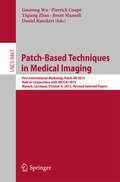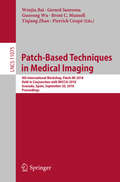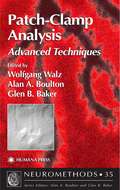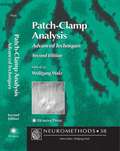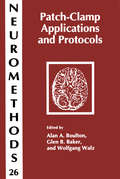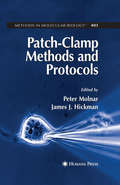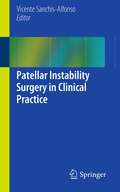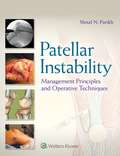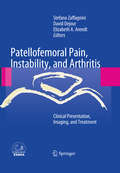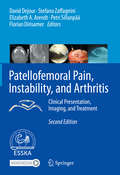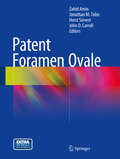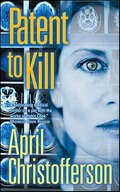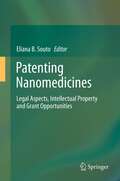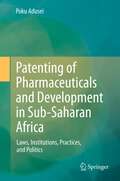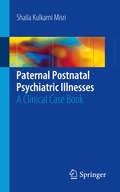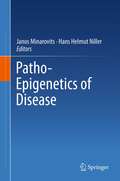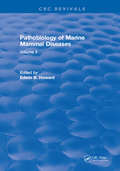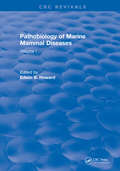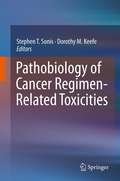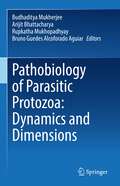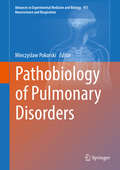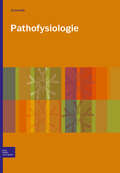- Table View
- List View
Patch-Based Techniques in Medical Imaging
by Guorong Wu Pierrick Coupé Yiqiang Zhan Brent Munsell Daniel RueckertThis book constitutes the thoroughly refereedpost-workshop proceedings of the First International Workshop on Patch-based Techniquesin Medical Images, Patch-MI 2015, which was held in conjunction with MICCAI2015, in Munich, Germany, in October 2015. The 25 full papers presented in this volume werecarefully reviewed and selected from 35 submissions. The topics covered are suchas image segmentation of anatomical structures or lesions; image enhancement;computer-aided prognostic and diagnostic; multi-modality fusion; mono and multimodal image synthesis; image retrieval; dynamic, functional physiologic andanatomic imaging; super-pixel/voxel in medical image analysis; sparsedictionary learning and sparse coding; analysis of 2D, 2D+t, 3D, 3D+t, 4D, and4D+t data.
Patch-Based Techniques in Medical Imaging: First International Workshop, Patch-mi 2015, Held In Conjunction With Miccai 2015, Munich, Germany, October 9, 2015, Revised Selected Papers (Lecture Notes in Computer Science #9467)
by Guorong Wu Pierrick Coupé Yiqiang Zhan Brent C. Munsell Wenjia Bai Gerard SanromaThis book constitutes the refereed proceedings of the 4th International Workshop on Patch-Based Techniques in Medical Images, Patch-MI 2018, held in conjunction with MICCAI 2018, in Granada, Spain, in September 2018. The 15 full papers presented were carefully reviewed and selected from 17 submissions. The papers are organized in the following topical sections: Image Denoising¸ Image Registration and Matching, Image Classification and Detection, Brain Image Analysis, and Retinal Image Analysis.
Patch-Clamp Analysis
by Alan A. Boulton Wolfgang Walz Glen B. BakerPatch-Clamp Analysis: Advanced Techniques describes in reproducible detail all applications that involve patch pipet. Beginning with updated basic patch-clamp techniques, the book presents the newest developments, ranging from fast external solution switching and the switching of the pipet solution during recording, to the loose patch, the perforated patch, and the patch cram detection technique. The advanced techniques covered combine molecular biology and imaging to produce the patch pipet with RT-PCR and fluorometric techniques.
Patch-Clamp Analysis
by Wolfgang WalzContinuing the research of the best-selling first edition, this second edition collects three more years of research in the ever-expanding study of the cell membrane. It covers the latest developments in the "traditional" patch techniques. This authoritative second edition updates the standard techniques while introducing three brand new, cutting-edge technical advances in the field. Thorough and timely, this edition is an invaluable resource.
Patch-Clamp Applications and Protocols
by Alan A. Boulton Wolfgang Walz Glen B. BakerPatch-Clamp Applications and Protocols presents the broadest coverage of techniques for measuring and recording directly activity within a cell. The first part of the book offers modern developments associated with the technology of path-clamp electrodes, of cell-free ion-channel recording, and of the whole-cell patch clamp technique. Chapters on such recent offspring of the technique as the concentration clamp technique, the pressure clap method, and the perfusion of patch clamp electrodes are contributed by authors intimately involved with their development. Also covered is the loose patch-clamp technique, single-channel recording, the perforated patch-clamp technique, molecular biological aspects of the technique, and the use of the technique in brain slices. Every scientist working with path-clamp methods will find this protocols manual invaluable to their continued use and development of this powerful technique.
Patch-Clamp Methods and Protocols
by Peter Molnar James J. HickmanPatch Clamp Methods and Protocols surveys the typical patch clamp applications and advises scientists on identifying problems and selecting the best technique in each instance. The experiments described aid the researcher in pursuing new areas of electrophysiology and using the patch clamp technique effectively. The volume includes an extensive theoretical treatise concerning single channel kinetic analysis.
Patellar Instability Surgery in Clinical Practice
by Vicente Sanchis-AlfonsoAmong all the extensor mechanism pathologies, lateral patellar instability is of great interest not only for the knee specialist, but also for the general orthopedic surgeon and trainee. The procedure that is most frequently performed to treat lateral patellar instability is the medial patellofemoral ligament (MPFL) reconstruction. The reason for this great interest in this procedure is obvious. Medial patellofemoral ligament reconstruction is the most frequently performed procedure in the extensor mechanism. It also is the most predictable and has the best clinical results of all the procedures in the extensor mechanism. In this handbook we analyse the different reconstruction techniques, step by step, for the MPFL reconstruction, as well as other techniques less frequently used in the patient with lateral patellofemoral instability. We also analyse the treatment of medial patellofemoral instability. It is a very practical book, aimed at the general orthopedic surgeon and also the ones specialized in the knee.
Patellar Instability: Management Principles and Operative Techniques
by Shital N. ParikhWritten by experts in the field, Patellar Instability and Dislocation: Classification and Operative Techniques is a comprehensive, authoritative review of the procedures used to address this challenging condition. Includes step-by-step procedures, both in print and on video, to guide you through today's most effective approaches to stabilization and reconstruction, trochleoplasty, limb realignment osteotomy, and much more.
Patellofemoral Pain, Instability, and Arthritis
by Elizabeth A. Arendt Stefano Zaffagnini David DejourDespite numerous studies, a lack of consensus still exists over many aspects of patellofemoral pain, instability, and arthritis. This book adopts an evidence-based approach to assess each of these topics in depth. The book reviews general features of clinical examination and global evaluation techniques including the use of different imaging methods, e.g. x-rays, CT, MRI, stress x-rays, and bone scan. Various conservative and surgical treatment approaches for each of the three presentations - pain, instability, and arthritis - are then explained and assessed. Postoperative management and options in the event of failed surgery are also evaluated. Throughout, careful attention is paid to the literature in an attempt to establish the level of evidence for the efficacy of each imaging and treatment method. It is hoped that this book will serve as an informative guide for the practitioner when confronted with disorders of the patellofemoral joint.
Patellofemoral Pain, Instability, and Arthritis: Clinical Presentation, Imaging, and Treatment
by Elizabeth A. Arendt Stefano Zaffagnini David Dejour Petri Sillanpää Florian DirisamerThis excellently illustrated book adopts an evidence-based approach to evaluate the efficacy of different techniques for the imaging and treatment of patellofemoral pain, instability, and arthritis. The aim is to equip practitioners with an informative guide that will help them to manage disorders of the patellofemoral joint by casting light on the many issues on which a consensus has been lacking. The opening chapters supply essential background information and explain the role of various imaging modalities, including radiography, CT, MRI, and bone scan. The various conservative and surgical treatment approaches for each of the three presentations – pain, instability, and arthritis – are then described and assessed in depth, with precise guidance on indications and technique. Postoperative management and options in the event of failed surgery are also evaluated. Throughout, careful attention is paid to the literature in an attempt to establish the level of evidence for each imaging and treatment method. The new edition has been thoroughly updated, with inclusion of additional chapters, in order to present the latest knowledge on biomechanics, diagnosis, surgical techniques, and rehabilitation.
Patent Foramen Ovale
by Horst Sievert Zahid Amin Jonathan M. Tobis John D. CarrollThis book is the ultimate reference on patent foramen ovale (PFO), a defect in the septum of the heart estimated to be present in more than twenty percent of the adult population and a proven cause of systemic embolism. All chapters have been written by internationally recognized experts in the field and cover PFO genetics and anatomy in addition to the effect PFO can have on various different organs and its supposed involvement in several conditions and clinical syndromes such as migraine, diving incidence, platynea orthodeoxia, economy class syndrome, sleep apnea and persistent desaturations in mild right ventricular dysfunction. As PFO anatomy varies significantly between individuals, chapters have also been included on the diagnostic tools, methods and techniques for appropriate assessment, detection and characterization of PFO. Furthermore, the multitude of available closure devices and techniques for PFO closure are discussed together with current and ongoing trial data. The book concludes with guidance and instruction on establishing a successful PFO program. Patent Foramen Ovale will be an essential text for the whole adult and pediatric interventional community, general cardiologists, internists, primary care physicians, neurologists and device companies in addition to medical students, graduate students and fellows in training.
Patent to Kill
by April ChristoffersonChristofferson's gripping novels of medical suspense have drawn favorable comparisons to the work of Michael Crichton and Robin Cook. Now she returns with a page-turning thriller that explores the cutting edge of medicine--and murder.It is a new crime for a new century. Biopiracy: the theft of the healing secrets of isolated, indigenous peoples. Rapacious pharmaceutical companies swoop down on remote Third World tribes, steal their folk medicine, native cures, and even human blood, then reap tremendous profits from the patents.Dr. Jake Scully doesn't want to think that his employer, Genchrom, is exploiting anyone, let alone killing natives for the unique properties of their DNA, but when he tries to blow the whistle on the company's criminal activities, he places his own life--and his family--in danger.At the Publisher's request, this title is being sold without Digital Rights Management Software (DRM) applied.
Patenting Nanomedicines
by Eliana B. Souto"Patenting Nanomedicines: Legal Aspects, Intellectual Property and Grant Opportunities" focusses on the fundamental aspects of Patenting Nanomedicines applied in different "Drug Delivery and Targeting Systems". The promoters of new findings in this field of research are numerous and spread worldwide; therefore, managing intellectual property portfolios, and the acquisition and exploitation of new knowledge face several contingency factors. Today, the scientific community is discussing issues of economic outcomes in the field of Nanomedicines. Major concerns include questions as to whether the research groups, academics, industry and other stakeholders should work in unison or independently, if innovation or adaptation of new technology should be prioritized, public versus private research funding, and safeguarding versus sharing knowledge. However, despite its increasing importance for humankind, it is a matter of concern as to whether technological development can really be stimulated by patent protection. An intellectual property strategy should aim to develop a qualitative patent portfolio for continuous learning. This book addresses questions of ethics, socio-political policies and regulatory aspects of novel Nanomedicine-based products which are currently under development for the diagnosis and treatment of different types of diseases. It is divided in two parts - Part I is composed of the first 3 chapters, which focus on the "fundamentals" of legal aspects, emerging threats, advantages and disadvantages of patenting Nanomedicines, whereas Part II collects 12 chapters discussing different types of Nanomedicine-based products, their potential marketing aspects and patent protection. Whenever applied, each chapter offers a list of patents, based on a specific application in drug delivery and targeting. An outstanding team of 53 authors have contributed to this book, which will be of interest to professionals from the field of patent examiners, academics, researchers and scientists, students and other practitioners.
Patenting of Pharmaceuticals and Development in Sub-Saharan Africa
by Poku AduseiThis book critically investigates the patent protection of medication in light of the threats posed by HIV/AIDS, malaria and tuberculosis epidemics to the citizens of countries in Sub-Saharan Africa (hereinafter "SSA" or "Africa"). The book outlines the systemic problems associated with the prevailing globalized patent regime and the regime's inability to promote access to life-saving medication at affordable prices in SSA. It argues that for pharmaceutical patents to retain their relevance in SSA countries, human development concepts must be integrated into global patent law- and policy-making. An integrative approach implies developing additional public health and human development exceptions/limitations to the exercise of patent rights with the goal of scaling up access to medication that can treat epidemics in SSA. By drawing on multiple perspectives of laws, institutions, practices, and politics, the book suggests that SSA countries adopt an evidence-based approach to implementing global patent standards in domestic jurisdictions. This evidence-based approach would include mechanisms like local need assessments and the use of empirical data to shape domestic patent law-making endeavors. The approach also implies revising patent rules and policies with a pro-poor and pro-health emphasis, so that medication will be more affordable and accessible to the citizens of SSA countries. It also suggests considering the opinions of individuals and pro-access institutions in enacting crucial pieces of health-related statutes in SSA countries. The approach in this book is sensitive to the public health needs of the citizens affected by epidemics and to the imperative of building local manufacturing facilities for pharmaceutical research and development in SSA.
Paternal Influences on Human Reproductive Success
by Douglas T. CarrellHistorically, sperm have been seen as simply a mechanism of transferring a haploid set of chromosomes to the oocyte. However, data from assisted reproduction therapies (ART) have demonstrated that in many couples the sperm appears to be responsible for abnormal embryogenesis. Recent advances in genetic and epigenetic techniques have identified key mechanisms by which the sperm, and the DNA carried by the sperm, can affect early embryonic development. Paternal Influences on Human Reproductive Success examines the genetic and epigenetic influences on embryogenesis, as well as practical clinical factors related to the male contribution to reproductive success. It also provides 'cutting edge' data and analysis of recent evaluations of the role of advanced paternal age, environmental influences and lifestyle factors on male reproductive fitness, making this an invaluable text for physicians treating patients for infertility, recurrent pregnancy loss, and developmental anomalies, as well as basic scientists studying embryogenesis and spermatogenesis.
Paternal Postnatal Psychiatric Illnesses: A Clinical Case Book
by Shaila Kulkarni MisriThis book is the first to present the current research showing that like mothers, some fathers struggle with postpartum psychiatric illnesses and have unique needs of their own. Each chapter opens with a case vignette that describes different psychopathologies in the father and demonstrates the unique struggles presented by each situation. The cases highlight social, emotional and cultural upheaval that fathers may experience during the postpartum period. Sections in each chapter include manifestations of their illness, DSM-5 diagnoses, case discussion, treatment interventions and recommendations for health care professionals. This volume also puts paternal postpartum depression into conversation with other psychiatric comorbidities, including various personality disorders, anxiety disorders, and addictions. The text also addresses the various stigmas associated with these unique cases and offers clinical pearls on how to treat these families while giving consideration to the needs of the family.Written by renown experts in postpartum health, Paternal Postnatal Psychiatric Illnesses is an excellent resource for psychiatrists, psychologists, family therapists, general practitioners, obstetricians, social workers, and all clinicians working with postpartum families.
Paternity: The Elusive Quest for the Father
by Nara B. MilanichFor most of human history, paternity was uncertain. Blood types, fingerprinting, and, recently, DNA analysis promised to solve the riddle of paternity. But even genetic certainty did not end the quest for the father. Rather, as Nara Milanich reveals, it confirms the social, cultural, and political nature of the age-old question: Who’s your father?
Patho-Epigenetics of Disease
by Hans Helmut Niller Janos MinarovitsIn multicellular organisms the establishment, maintenance, and programmed alterations of cell-type specific gene expression patterns are regulated by epigenetic mechanisms. Thus, epigenetic alterations (DNA methylation, DNA associated Polycomb-Trithorax protein complexes, histone modifications) ensure the unique transcriptional activity and phenotypic diversity of diploid cells that carry identical or nearly identical DNA sequences. Because DNA methyltransferase I (DNMT1) associates with replication foci during S phase and prefers hemimethylated DNA as a substrate, DNMT1 ensures the clonal propagation of cytosine methylation patterns (maintenance methylation). Thus, DNA methylation may provide a memory function by helping progeny cells to "remember" their proper cellular identity. An alternative system of epigenetic memory, the Polycomb and Trithorax groups of protein complexes, that may operate both independently from and in concert with DNA methylation, ensures the heritable regulation of gene expression via modification of histone tails. The complex interplay of epigenetic regulatory mechanisms permits both the dynamic modulation of gene expression and the faithful transmission of gene expression patterns to each progeny cell upon division. These carefully orchestrated processes can go wrong, however, resulting in epigenetic reprogramming of the cells that may manifest in pathological changes, as it was first realized during the studies of epigenetic alterations in malignant tumors. By now it became a well established fact that not only genetic changes, but also the disruption of epigenetic regulation can result in carcinogenesis and tumor progression. Scientists working in other fields soon followed the pioneering work of cancer researchers, and revealed that epigenetic dysregulation forms the basis of a wide spectrum of human diseases.
Patho-Epigenetics of Infectious Disease
by Hans Helmut Niller Janos MinarovitsEpigenetic modification of cellular genomes is a fascinating means of regulating tissue- and cell type-specific gene expression in all developmental stages of the life of an organism. Carefully orchestrated processes, such as DNA methylation and a plenitude of specific histone modifications secure the faithful transmission of gene expression patterns to progeny cells. Upon chronic infection, the epigenetic cellular balance can become disrupted and, in the long run, through the epigenetic reprogramming of host cell genomes, contribute to the malignant conversion of formerly healthy cells, in many cases preceded by the establishment of an epigenetic field of cancerization. The present volume undertakes to highlight the interactions of infectious pathogens and their effector molecules with the epigenetic regulatory machinery of the cell. Clearly, the recent take-off of epigenetics research did not leave Research on Infectious Diseases and Infection-Associated Cancer untouched. This resulted in a great many of clinically relevant data on understanding the molecular mechanisms of chronic infectious disease. Infectious pathogen- and disease-specific epigenetic alterations are already being used for the early detection of malignant disease and for the prediction of chemotherapy resistance or response to treatment.
Pathobiology Of Marine Mammal Diseases: Volume I
by HowardThese volumes provide information which will be helpful to comparative pathologists, veterinarians, and all marine scientists and other individuals who are interested in the study of marine mammals, and the diseases they develop in both their feral and captive environment.This publication is a reflection of the observations of the various authors, some of whom have pioneered in this field, and is an attempt to update the available information concerning the natural diseases, and the corresponding pathologic changes in marine mammals.
Pathobiology Of Marine Mammal Diseases: Volume II
by Edwin B. HowardThese volumes provide information which will be helpful to comparative pathologists, veterinarians, and all marine scientists and other individuals who are interested in the study of marine mammals, and the diseases they develop in both their feral and captive environment.This publication is a reflection of the observations of the various authors, some of whom have pioneered in this field, and is an attempt to update the available information concerning the natural diseases, and the corresponding pathologic changes in marine mammals.
Pathobiology of Cancer Regimen-Related Toxicities
by Dorothy M. Keefe Stephen T. Sonis, DMD, DMScThe contents of this book will be organized into three sections. The first section defines the scope, impact and behaviour of cancer regimen-related toxicities and frames the issue of balancing treatment success and physiological cost. In the second segment of the book, the most current thinking around the pathobiology of specific, common, and representative toxicities is presented by leading researchers and translational scientists. The final portion of the book discusses the common biological relationships between toxicities, bioinformatical approaches to analysing key and common pathways, and strategies for the development of effective interventions.
Pathobiology of Parasitic Protozoa: Dynamics and Dimensions
by Budhaditya Mukherjee Arijit Bhattacharya Rupkatha Mukhopadhyay Bruno Guedes Alcoforado AguiarThis book illustrates the importance and significance of the systems approach in deciphering diverse aspects of host-parasite interactions in infection dynamics. It describes the complex issues and state-of-the-art progress in the infection biology of parasitic protozoa. The book explores the current concepts and paradigms of gene expression, metabolome, and immune remodeling in these diseases. The chapters encompass updates on the parasitic tropism, co-evolution, systemic responses in hosts, and translational approaches. It provides an overview of the parasite's efficient ways of exploiting host molecules and describes pathways for their survival, differentiation, and replication within the host cells. The book also delineates the role of inflammasomes and their activation in response to the protozoan parasite. The book discusses technological progress and machine learning-based modeling approaches to revisit parasitic infection from a non-conventional perspective. Collectively this book offers a comprehensive purview of concepts and paradigms in parasitic infection in the form of an updated yet discernible elucidation.
Pathobiology of Pulmonary Disorders
by Mieczyslaw PokorskiPulmonary disorders significantly contribute to the current level of disease burden. Effective disease management is essential for improving clinical outcomes and quality of life. This book highlights the issues involved with diagnosing and managing various pulmonary conditions such as chronic obstructive pulmonary disorders, respiratory tract infections, including those developing as a sequel of antibiotic treatment, and others. Investigations on novel diagnostic procedures and potential biomarkers of diseases are discussed, along with diseases presentations and management. Preventive measures related to lifestyle and air quality, with the implications on patients care, are tackled as well. Progress in clinical savvy is inseparably linked with getting insight into the pathogenesis of the condition. This book presents views and information on the research developments in the rapidly changing field of pneumology. Target readership: clinicians and researchers, family practitioners, and trainees.
Pathofysiologie
by J. A. GroeninkPathofysiologieZiekte is niets anders dan een gestoorde fysiologie. De pathofysiologie onderzoekt de mechanismen die tot deze verstoringen leiden en vormt de basis van de interne geneeskunde. Degenen die al over een behoorlijke medische kennis beschikken, kunnen kiezen uit een groot scala aan diepgaande, overzichtelijke, en omvangrijke leerboeken over interne geneeskunde waarin de pathofysiologie wordt behandeld. De meeste standaardwerken houden echter geen rekening met het kennisniveau van de beginnende student.Pathofysiologie is een toegankelijk leerboek. Het boek bevat hoofdstukken over hart, longen, nieren en het endocriene stelsel. Om deze kennis goed op te kunnen nemen, is enig begrip van de elementaire celbiologie vereist Daarom worden in het eerste hoofdstuk de genetica en het functioneren van de cel uiteengezet. Het leerboek eindigt met een introductie tot de immunologie.Deze twee leergebieden (genetica en immunologie) zullen in de nabije toekomst steeds nadrukkelijker hun stempel zetten op de medische zorg. De anatomie wordt slechts behandeld voor zover dit nodig is voor het begrip van de fysiologie.Deze twee leergebieden (genetica en immunologie) zullen in de nabije toekomst steeds nadrukkelijker hun stempel zetten op de medische zorg. De anatomie wordt slechts behandeld voor zover dit nodig is voor het begrip van de fysiologie.
